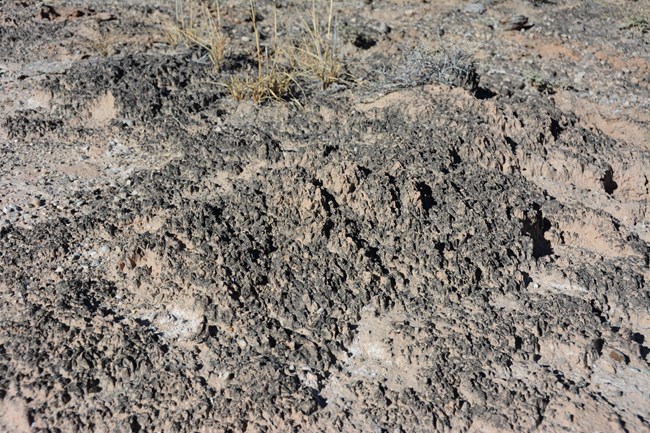
NPS Biological soil crusts are found throughout the world and play important roles in the ecosystems in which they occur. In arid regions, these living soil crusts are dominated by cyanobacteria and also include soil lichens, mosses, green algae, microfungi and bacteria. In the high deserts of the Colorado Plateau (which includes parts of Utah, Arizona, Colorado and New Mexico), these knobby black crusts are extraordinarily well-developed, and may represent 70 to 80 percent of the living ground cover. 
NPS Environmental ImpactsUnfortunately, many human activities are incompatible with the presence and well-being of biological soil crusts. The fibers that confer such tensile strength to these crusts are no match for the compressional stress placed on them by footprints or machinery, especially when the crusts are dry and brittle. Air pollutants, both from urban areas and coal-fired power plants, also harm these crusts. Tracks in continuous strips, such as those produced by vehicles or bicycles, are especially damaging, creating areas that are highly vulnerable to wind and water erosion. Rainfall carries away loose material, often creating channels along these tracks, especially when they occur on slopes. Wind not only blows pieces of the pulverized crust away, thereby preventing reattachment to disturbed areas, but also disturbs the underlying loose soil, often covering nearby crusts. Since crustal organisms need light to photosynthesize, burial can mean death. When large sandy areas are impacted during dry periods, previously stable areas can become a series of shifting sand dunes in just a few years. Impacted areas may never fully recover. Under the best circumstances, a thin veneer of biological soil crust may return in five to seven years. Damage done to the sheath material, and the accompanying loss of soil nutrients, is repaired slowly during up to 50 years of cyanobacterial growth. Lichens and mosses may take even longer to recover. Don't Bust the Crust

NPS/ C. Roundtree What is Cyanobacteria?Cyanobacteria, previously called blue-green algae, are some of the oldest known life forms. It is thought that these organisms were among the first land colonizers of Earth's early land masses, and played an integral role in the formation and stabilization of early soils. The earliest cyanobacteria fossils found are called stromatolites, which date back more than 3.5 billion years. Extremely thick mats of these organisms converted Earth's original carbon dioxide rich atmosphere into one rich in oxygen and capable of sustaining life. Learn More! |
Last updated: February 20, 2021
